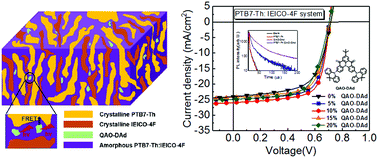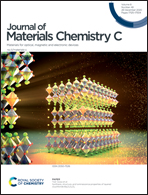Delayed fluorescence material-assisted high performance ternary organic solar cells realized by prolonged exciton lifetime and diffusion length†
Abstract
In organic solar cells (OSCs), the power conversion efficiency (PCE) is largely influenced by the number of photo-generated excitons reaching the interface between the donor and the acceptor domains before recombination. To improve the utilization rate of excitons, QAO-DAd, a delayed fluorescence (DF) material with a small singlet triplet energy level difference, was introduced into the PTB7-Th : IEICO-4F system. The optimized ternary OSCs show a high average PCE of 12.72%, which is higher than that of the control devices (11.39%). The improved PCE of the ternary OSCs may be due to the prolonged exciton lifetime and diffusion length. The modulated micro morphology of the active layer, and the promoted processes of exciton disaggregation and charge transmission are also important for device performance improvement. Furthermore, the stability of the ternary devices is improved compared to the control devices. Furthermore, when QAO-DAd was applied to the PTO2 : IT-4F system, the optimized ternary devices achieved a champion PCE of 14.07%, which was superior to that of the binary OSCs (PCE of 13.01%), indicating the adaptability of the ternary strategy. These results suggested that the ternary strategy of introducing a DF material is effective and handy in achieving high performance OSCs.



 Please wait while we load your content...
Please wait while we load your content...